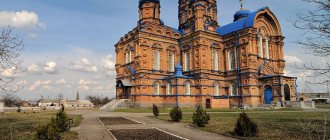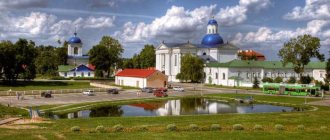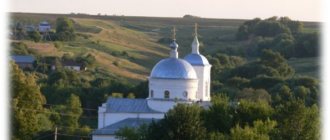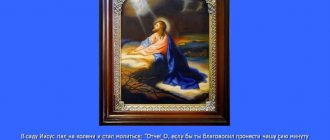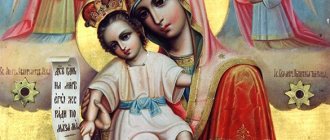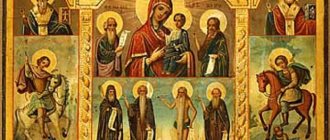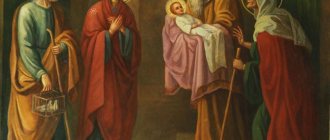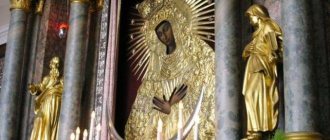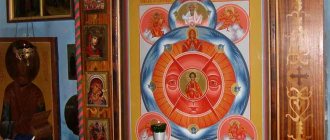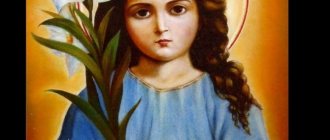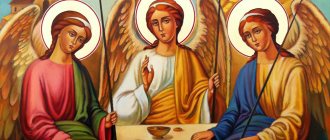This image of the Virgin Mary is considered quite rare and unlike others. You can’t meet him in every Orthodox church. The ancient image of the Virgin Mary is known for its miraculous properties and ability to help all true Christian believers. It was in front of him that the last Russian Emperor Nicholas II and members of his family prayed. According to the new style, the days of remembrance of the icon fall on July 11 and July 25 (June 28 and July 12 according to the Julian calendar). With their onset, believers give each other sincere congratulations, glorify the Mother of God and ask for Her heavenly support.
Description and meaning of the image
The painting “Three Hands” looks unusual. It is classified as a type of Hodegetria - images of the Virgin Mary with the Child. In the icon, the Mother of God holds the little Savior in her right hand. With her left palm, the Queen of Heaven points to Jesus, implying the path to the salvation of all mankind.
There is a “third” hand in the image. Sometimes it is drawn directly on the icon. In other paintings it is an element made of noble metal and applied to the surface.
The third brush can have two meanings:
- the hand drawn away from the Virgin Mary symbolizes Her protection, grace and mercy towards believers;
- the palm belonging to the Mother of God herself implies the protection and blessing emanating from Her.
The “Three-Handed” icon reminds us of the need for humble service to the Lord, purification of the soul, and the desire for sincere faith throughout human life. For Christians who turn to her with prayer requests, she becomes a reliable protector and helper in many difficult situations.
Troparion
Today, great worldwide joy has arisen for us: Thy celibate-bearing icon has been given to the holy Mount Athos, the Lady Theotokos, with the image of Thy three-numbered and indivisibly most pure hands, for the glorification of the Holy Trinity, calling for the faithful and those who pray to You to know this, as two imashes you hold the Son and the Lord , the third, show as a refuge and protection to those who honor You from all misfortunes and troubles, so that all who flow to You by faith, receive abundant liberation from all evils, protection from enemies, for this sake we, together with Athos, cry out: Rejoice, Gracious One, Lord with you.
Origin story
The appearance of the “Three-Handed” icon is traditionally associated with St. John of Damascus. This saint lived in the 7th century, during the reign of the Byzantine emperor Leo III the Isaurian, who approved of the persecution of the Christian faith.
One day, John, who was acting as an adviser at the court of the Syrian caliph, wrote a letter to Leo III the Isaurian. In his message he defended icons and their veneration. The vindictive Byzantine emperor decided to take revenge on him for such a bold act. He managed to do this even at a distance, writing a letter to the caliph in which he accused John of treason and betrayal. After this, the righteous man’s right hand was cut off and hung for public viewing in the square.
On the same day, an unheard of miracle happened. The brush was returned to John of Damascus, after which he put it in its original place and began to fervently ask the Mother of God for healing. After this, the monk fell asleep and saw in a dream the Queen of Heaven, who fulfilled his request and commanded him to work with his right hand for the good of the Orthodox faith. Waking up, John was incredibly happy: his hand had grown back, and only a barely noticeable scar remained on his hand.
Wanting to express deep gratitude to the Most Pure Mary, the righteous man created a song of praise to Her, “He rejoices in you...”. He decided to decorate the icon of the Mother of God, in front of which Saint John prayed, with the image of a hand made of silver. This is how a new iconographic image appeared, called “Three-Handed”.
Prayer
Oh, Most Holy and Most Blessed Virgin, Mother of God Mary! We fall down and worship You before Your holy icon, remembering Your glorious miracle, the healing of the truncated right hand of the Venerable John of Damascus, which was revealed from this icon, whose sign is still visible on it, in the form of a third hand, attached to Your image.
We pray to You and ask You, the All-merciful and All-generous Intercessor of our race: hear us, praying to You, and like blessed John, who cried out to You in sorrow and illness, you heard us, so do not despise us, those who grieve and suffer from the wounds of many different passions, do not despise , those who diligently come running to You from a contrite soul.
You see, O All-Merciful Lady, our infirmities, our embitterment, our need, I will need Your help, as enemies surround us from everywhere, and there is no one who helps, less than one who intercedes, unless You have mercy on us, the Lady.
To her, we pray to You, listen to our painful voice and help us to preserve the patristic Orthodox faith immaculately until the end of our days, to walk unswervingly in all the commandments of the Lord, to always bring true repentance for our sins to God and to be honored with a peaceful Christian death and a good answer at the terrible judgment of the Son Yours and our God. Beseech Him for us with Thy motherly prayer, that He may not condemn us according to our iniquity, but may He have mercy on us according to His great and ineffable mercy.
O All-Good One! Hear us and do not deprive us of Your sovereign help, yes, having received salvation through You, let us sing and glorify You on the land of the living and our Redeemer, the Lord Jesus Christ, who was born of You, to Him belong glory and power, honor and worship, together with the Father and the Holy Spirit , always, now and ever and forever and ever. Amen.
Where is the image now?
After some time, John of Damascus gave the icon of the Mother of God to the monastery of St. Sava, located in the Judean desert. In the 13th century, the painting was presented as a gift to the Serbian archbishop. Another century later, during the conquest of Serbia by the Turks, Christians decided to save the image of the Blessed Virgin Mary from the aggressors. The believers tied him to the back of a donkey, which independently came to the Athos monastery of Hilandar. This is where the original image remains to this day.
The icon has many lists. One of the most famous is kept in Bulgaria, in the Troyan Monastery. On the territory of Russia, the image of “Three Hands” can be seen in the Transfiguration Cathedral of the city of Chernigov, in the Resurrection New Jerusalem Monastery in the Moscow region, in the Church of the Assumption in Gonchary (Bulgarian Compound), in the Moscow St. Daniel Monastery. In Ukraine, the image of the Mother of God “Three Hands” is kept in the Kiev Holy Trinity Monastery of St. John.
Greatness
First: We magnify You, Most Immaculate Virgin, and honor the miracles of Your holy image, the appearance of Your three most pure hands to the glory of the Divine, in the Trinity of our God.
Second: We magnify You, Most Holy Virgin, and honor the three-numbered image of Your most pure hands, for You hold the Son and the Lord as two, and with the third you deliver us from misfortunes and troubles.
Read us conveniently on social networks:
Tags: three-handed icon of the Mother of God, three-handed icon, three-handed icon, what helps with, three-handed icon meaning
What miracles is the painting famous for?
The icon revealed a large number of miraculous events to Christian believers. The most famous among them:
- a story that happened in Hilandar. When the abbot of this monastery died, the brethren could not decide on the appointment of a new abbot. The Mother of God herself came to their aid. She made the “Three-Handed” icon inexplicably appear in the place of the abbot. Then the Queen of Heaven came to one of the monks in a dream and expressed a desire to rule the monastery. Since that very day, the Virgin Mary has tirelessly looked after the monastery, which throughout its existence has never been destroyed;
- typhus epidemic in Kyiv. Disease swept through this large city in the 19th century. To protect people from a dangerous disease, the clergy constantly held services at the “Three-Handed One”. Soon the typhus subsided, and many patients escaped death and successfully recovered. The icon, which demonstrated its miraculous power, is still kept in the Ukrainian capital;
- expulsion of robbers from the Hilandar monastery. As the Greek Civil War (1946–1949) unfolded, rebels invaded the Athos Peninsula and attacked Hilandar. While removing monastery property, the robbers suddenly saw a woman in long robes enter the temple. The rebels who followed her ended up at the “Three-Handed” icon of the Mother of God, decorated with rich jewelry. When they tried to steal these treasures, they felt fear and awe, after which they fled, abandoning all the loot in horror;
- hand healing. The incident occurred on Russian soil. A woman came to venerate the icon; one of her upper limbs had been mutilated by acid. After sincere prayer and touching the image of the Mother of God, her wounds began to heal before our eyes, leaving no traces behind.
Even the ordinary paper image “Three Hands” has great power. An inexplicable event took place in the 90s. last century in Serbia, where a fire broke out in one of the workshops. When the flame, which was destroying everything around, reached the icon, it suddenly went out, causing no harm to either the image printed on the paper or the objects located next to it.
Day of Remembrance
The memory of the icon is celebrated twice a year:
- July, 12;
- July 25.
Cases of help today
Nowadays the “Three-Handed” icon can be found in almost any church. The number of copies of the image, revered as miraculous, is also large.
Here are just a few cases of help to the Mother of God, collected by the sisters of the Assumption Feklina women's hermitage (Kaluga region), where one of the lists has been located since 2009.
During this time, this old, dark icon was wonderfully renewed. The sisters testify that the miracle of renewal continues. In addition, the face of the Mother of God changes: sometimes it becomes bright, sometimes Her eyes are filled with tears. Many pilgrims come to the Akathist of the Most Pure One. Many, in addition to their names, submit notes asking the Mother of God for help, which are also read during the service.
Healing without surgery
The abbess of the monastery, Vitalia (Kochetova) says:
“The Mother of God herself healed me: I have a heart defect, and an operation was already scheduled, but it was not required. The doctors said, “If it weren’t for the old ultrasound results, we would never have believed that you had a heart defect.”
It happened that pilgrims came to us to pray before the miraculous image for the successful outcome of the operation - in the end, the matter was managed without any operation at all, and the patient was safely discharged.”
Found a job
“One girl could not find a job for a long time and prayed in front of the icon, asking the Mother of God not even for work, but to cope with difficulties without complaining.
After the pilgrims’ fervent prayer, not even ten minutes had passed before the girl received a call and was offered a job, and a well-paid one at that. The next day another job offer came. The girl was incredibly happy and amazed at how quickly the Most Holy Theotokos answered her prayer.”
First aid for illnesses, everyday troubles, pacification of enemies - all this is given by the Mother of God in our days, as many centuries ago, through Her icon. Sometimes just a glance at the image in front of which the great Damascus prayed for the impossible, relieves despair, despondency, and gives hope. And the Mother of God does not disgrace the hope of those who hope in Her.
Natalia Sazonova
What do they pray for in front of the icon?
Prayers before the Mother of God help in different situations:
- in case of illnesses of your own or those around you;
- with complete or partial loss of vision;
- with constant adversity and failure;
- in case of weakening of faith, the appearance of melancholy and despondency;
- in extreme poverty, inability to get out of poverty;
- while looking for a job or a new place of residence;
- in case of disagreements, striving for reconciliation of warring parties;
- in case of undeserved accusations, slander;
- in case of unjust conviction and imprisonment;
- after the loss of a loved one, with mental grief.
The icon has long been considered the patroness of people engaged in crafts, as well as housewives. Turning to the “Three-Handed One” facilitates the search for truth in controversial situations, allows you to find the correct answers to complex questions, and protects you from the machinations of ill-wishers. The face of the Blessed Virgin Mary helps to cleanse the soul from sinful thoughts and gain God's grace.
They pray in front of the image at home or in a temple, where they can be present at the reading of the akathist. You can turn to the Mother of God alone or with the whole family. They do this in different ways, both out loud and mentally, on an ordinary day or on the feast of the icon. People who often travel, are sick for a long time, or military personnel are advised to carry a small icon of the “Three-Handed Mother” with them and talk with the Mother of God in difficult moments.
What do they ask when they come to her?
- Naturally, most of all - health. People whose illness is related to their hands especially pray to the Three Hands.
- They also pray for eye health and good vision.
- And in general, they offer any prayers to her for the health of themselves or their loved ones, and she helps many.
- Craftsmen consider the Mother of God of Three Hands to be their patroness.
- It is also a protector against evil slander. If a person has been slandered, he asks the Mother of God to help the truth to be revealed.
- They ask to protect them from enemies and enemies, as well as “friends” with unclean thoughts.
- Many people turn to this icon if they feel that something is threatening their family peace or home.
- Finally, they ask to increase the family's welfare. And not in vain, because after the healing of John of Damascus, the Byzantine ruler believed that the sage could not wish him harm, forgave him, again brought him closer to himself and showered him with all sorts of gifts.
How to pray
Of course, if there is a specific request (something hurts, someone is preparing for surgery, someone’s good name is at risk), people address it in their own words.
But there are also certain prayers created specifically for this icon.
They sound like this:
You can learn more about the life and work of John of Damascus (emphasis on the last “and”), a saint about whom, unfortunately, most of our Orthodox believers know almost nothing, from this report video:
How to place an icon in the house
There are several ways to hang a painting indoors:
- in the main, “red” corner of the room;
- opposite the entrance (facing it).
It is important to ensure that the image is not blocked by anything. So the heavenly grace of the Virgin Mary will fully extend to the inhabitants and guests of the home.
Orthodox Christians claim: after placing the image of the Mother of God in the house, it is immediately possible to understand who is pleasing to God and whose essence is filled with evil. If a person is pure in soul and strives for good deeds, in the presence of the icon he will feel comfort and lightness. Individuals who are planning evil will not be able to stay in the room for long and will try to leave its walls as quickly as possible.
It is not recommended to place any decorations (embroidered towels, lace, natural or artificial flowers) near the “Three Hands”. On days when the Orthodox Church celebrates the memory of an icon, a blessed candle is lit in front of it. It is recommended to use a special stand for this.
Literature
- Bogdanoviħ D., Buriħ B., Medakoviħ D. Hilandar. Beograd, 1978. pp. 112–114.
- Bentchev I. Bibliographie der Gottesmutterikonen. Bonn, 1992, pp. 251–253.
- Bentchev I. Die „Dreihändige” Gottesmutterikone im Hilandar-Kloster auf Athos // Hermeneia. Zeitschrift für ostkirchliche Kunst. Bochum, 1993. 3. S. 46–52.
- Medakovic D. Hilandar. Beograd, 1978. pp. 112–114.
- Mirkoviħ L. Icon of the Mother of God of Three Hands // Iconographic studies. Novi Sad, 1974, pp. 233–235.
- Hamann-Mac Lean R., Hallensleben H. Die Monumentalmalerei in Serbien und Makedonien. Gieben, 1976. S. 58.
- Radojchiħ S. Umenichki spomenitsi manastira Hilandar // Collection of Radov SAN. Beograd, 1955. T. XLIV. P. 174.
- Tatiħ-ŋuriħ M., Trojeručica svetoga Save and њen cult in the Orthodox light // Collection of Radov, Beograd 1997. pp. 133–160.
